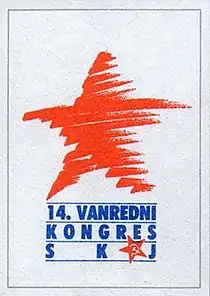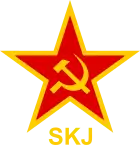14th Congress of the League of Communists of Yugoslavia
The 14th (Extraordinary) Congress of the League of Communists of Yugoslavia (Serbian Latin: Četrnaesti (vanredni) kongres Saveza komunista Jugoslavije, Cyrillic: Четрнаести (ванредни) конгрес Савеза комуниста Југославије) was held from 20 to 22 January 1990, in the Belgrade Sava Centar. The highest organ of both the government and the party, it was the last Congress of the League of Communists of Yugoslavia. It was attended by delegates from all the republics and provinces, as well as a party delegation from the Yugoslav People's Army. The meeting was chaired by President of the Presidency of the Central Committee Milan Pančevski from Macedonia.

Background
During the 1980s, Yugoslavia has faced a growing political and economic crisis that threatened the very survival of the federation. Conflicting strategies of the future of the nation, based both in republic's capitals, Belgrade, the power of the League of Communists, and its debt crisis finally separated on the 14th extraordinary Congress in January 1990.[1]
Preparations for congress
The regular congress of SKJ should be held in 1990, but it was suggested earlier, at the 18th session of the League of Communists of Yugoslavia, when this proposal was rejected. Then, on the 20th session, the delegation of Vojvodina again proposed the holding of an extraordinary congress, which was again rejected, while the same proposal at the 22nd session was not accepted. There was no single stance on whether this congress should be called extraordinary. Such a name was especially opposed by Slovenian delegation. On the issues to be addressed, especially those who referred to the future organization of Yugoslavia, the congress was indeed remarkable.
Number of participants
The elected delegates of the congress were 1,457, as follows:
- Serbia - 564 (including delegates of Vojvodina: 137 and Kosovo: 94),
- Bosnia and Herzegovina - 248,
- Croatia - 216,
- Macedonia - 141,
- Slovenia - 114,
- Montenegro - 99
- Yugoslav People's Army - 68,
- Federation authorities - 7 members
- SKJ authorities - 198 delegates
That was the total of 1,655 Congress delegates.[2]
Number of participants of the 1st plenary session According to the report of the Verification Commission, submitted after the 1st plenary session, 1,601 delegates with voting rights participated in the work of the congress.[3]
Number of participants of the 2nd plenary session At the beginning of the 2nd plenary session, 1,612 delegates voted in the work of the congress.[4]
The Congress
During the Congress, any illusions about a united LCY front that could bring the country out of crisis were dispelled.[1] Instead the Congress was dominated mostly by clashes between the Serbian and Slovenian delegations over the power and decision making process of the Constituent republics of Yugoslavia. The Serbian delegation advocated for the introduction of a policy of "one man - one vote", with a more centralized Yugoslavia. The Slovenes, however, suggested a confederation party and state, giving more power to the republics. All proposals of the Slovenian delegation, led by Milan Kučan, were rejected. At the same time, Serbian proposals were accepted on a majority vote, helped by Serbia's domination of the votes in Kosovo, Vojvodina and Montenegro.
After two days with a sharp verbal conflict, the Slovene delegation walked out of the Sava Center 22 January. Immediately thereafter, the head of the delegation from Serbia, Slobodan Milošević, suggested that Congress continue to work and move on to decision-making. However, this was strongly opposed by the delegation from Croatia, who argued this was unconstitutional. At the prompting of Slobodan Lang, Ivica Račan, head of the Croatian delegation approached the speaker and declared that "we (the SKH delegation) can not accept the Yugoslav party without the Slovenes". When Milošević asked what it would take to recommence the meeting, the Croatian delegation remarked "the Slovene delegation", and that if the meeting was recommenced they too would leave the proceedings. When attempts were made, the Croatian delegation were true to their word, and they too left, joined by the delegations of Macedonia and Bosnia and Herzegovina. At 22.45 Milan Pančevski called the day's proceedings to a close, and an adjournment for the following day, however, this did not happen, and the congress was never recalled.[5]
Yugoslavia faced an uncertain period after the Congress, without any significant cohesive force or individual that would lead to some kind of compromise or conciseness.[1] Soon after, the LCY was dissolved after 81 years of existence, ending 45 years of uninterrupted rule and paving the way for free elections. This event was one of the key moments for the beginning of the breakup of Yugoslavia.[1][6]
Sources
- Davor, Pauković (22 December 2008). "Last Congress of the League of Communists of Yugoslavia: Causes, Consequences and Course of Dissolution". Contemporary Issues (in Croatian). 1 (1). ISSN 1849-2428.
- Today, January 30, 1990: 8
- Politika, 21. 1.1990: 1).
- Vjesnik, 23.1.1990 .: 5.
- "Posljednji, 14. vanredni kongres SKJ". Magazin Plus. 20 January 2016. Retrieved 23 November 2020.
- Jović, B. (1996): The Last Days of the SFRY, Excerpts from the Diary , Belgrade: Politika
References
- Bilandžić, D. (1999): Croatian Modern History, Zagreb: Golden Marketing
- Cohen, LJ (1993): Broken Bonds: The Disintegration of Yugoslavia, Boulder-San Francisco-Oxford: Westview Press
- Duka, Z. (2005): Račan - Biography, Zagreb: Profile
- Goldstein, I. (2003): Croatian History, Zagreb: Novi Liber
- Jović, B. (1996): The Last Days of the SFRY, Izvodi iz dnevnika, Beograd: Politika
- Jović, D. (2003): Yugoslavia - the state that has died, Zagreb: Prometheus
- Milosavljević, O. (2004): The Antibiography Revolution 1987-1989. godine, u: Fleck, HG, Graovac, I. (ur.)
- Dialogue of Historians / Historians, 8, Zagreb: Friedrich Naumann Foundation
- Milošević, S. (1989.): Years of Expenditure, Belgrade: BIGZ
- Basic directions of SKH's action on society reform and SK, Naše teme, 1990 (3-4): 602-622
- Pauković, D. (2008): Pre-election campaign in Croatia in 1990 in the light of Croatian and Serbian news,
- Journal of Contemporary History, 2008 (1): 13-31
- Ramet, SP (2005): Balkan Babylon. The breakup of Yugoslavia from Tito's death to Milošević's fall, Zagreb: Alinea
- Silber, L., Little, A. (1996): Death of Yugoslavia, Opatija: Otokar Keršovani
